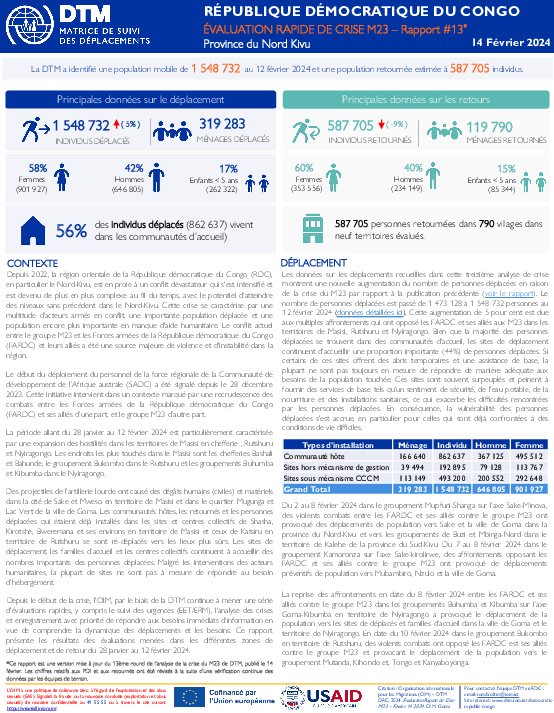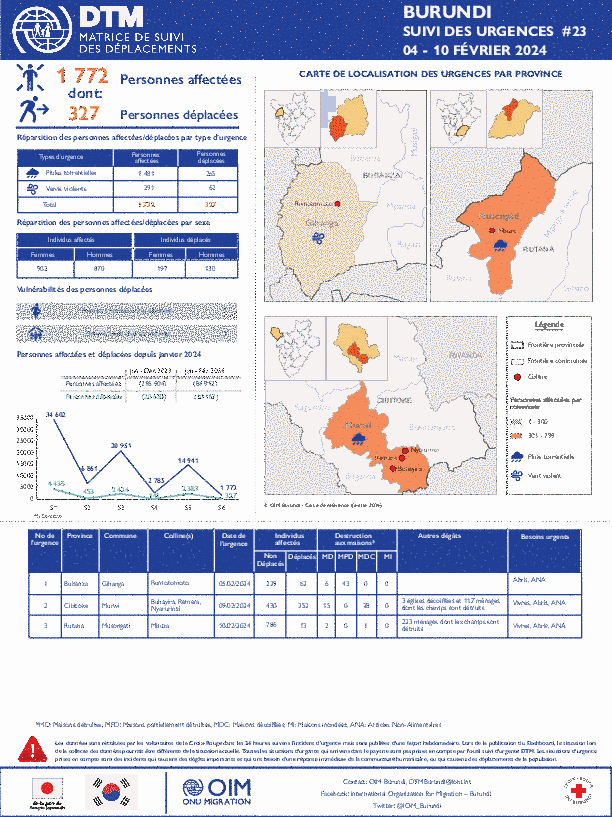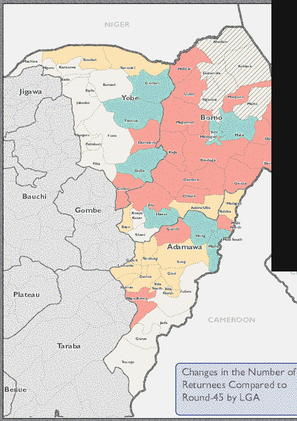-
Countries
-
Data and Analysis
-
Special Focus
-
Crisis Responses

Contact
DTMAfghanistan@iom.int
Language
English
Location
Afghanistan
Period Covered
Feb 04 2024
Feb 10 2024
Activity
- Survey
- Flow Monitoring Survey
- Flow Monitoring
In response to recent movements, IOM Afghanistan re-launched its DTM Flow Monitoring activity at the beginning of 2024 to better understand the mobility dynamics at Afghanistan’s borders. Since 10 January 2024, DTM has deployed field teams at four border crossing points with the Islamic Republic of Iran (IRN) and Pakistan (PAK) (see map below) to conduct two interlinked exercises. The first is a headcount of all individuals entering or leaving Afghanistan (including returnees), also called Flow Monitoring Counting (FMC), to gauge flow volume. The second is a survey of randomly selected Afghan national individuals or groups entering or leaving Afghanistan, also called the Flow Monitoring Survey (FMS), to understand the profiles, motivations, and vulnerabilities of the target population. This snapshot provides key findings combining various IOM data sources, including DTM Afghanistan’s FMC and FMS activities, DTM Pakistan’s Flow Monitoring of Afghan returnees, and IOM Afghanistan’s Cross-Border Post-Arrival Humanitarian Assistance (CB-PAHA) program, for the period 4 to 10 February 2024. For more information about methodology, see the the section in the last page of this report titled “IOM INFLOWS.”

Contact
DTM DRC, iomdrcdtm@iom.int
Language
French
Location
Democratic Republic of the Congo
Period Covered
Jan 28 2024
Feb 12 2024
Activity
- Mobility Tracking
- Event Tracking
Depuis 2022, la région orientale de la République démocratique du Congo (RDC), en particulier le Nord-Kivu, est en proie à un conflit dévastateur qui s'est intensifié et est devenu de plus en plus complexe au fil du temps, avec le potentiel d'atteindre des niveaux sans précédent dans le Nord-Kivu. Cette crise se caractérise par une multitude d'acteurs armés en conflit, une importante population déplacée et une population encore plus importante en manque d'aide humanitaire. Le conflit actuel entre le groupe M23 et les Forces armées de la République démocratique du Congo (FARDC) et leurs alliés a été une source majeure de violence et d'instabilité dans la région.
La période allant du 28 janvier au 12 février 2024 est particulièrement caractérisée par une expansion des hostilités dans les territoires de Masisi en chefferie , Rutshuru et Nyiragongo. Les endroits les plus touchés dans le Masisi sont les chefferies Bashali et Bahunde, le groupement Bukombo dans le Rutshuru et les groupements Buhumba et Kibumba dans le Nyiragongo.
Depuis le début de la crise, l'OIM, par le biais de la DTM continue à mener une série d'évaluations rapides, y compris le suivi des urgences (EET/ERM), l'analyse des crises et enregistrement avec priorité de répondre aux besoins immédiats d'information en vue de comprendre la dynamique des déplacements et les besoins. Ce rapport présente les résultats des évaluations menées dans les différentes zones de déplacement et de retour du 28 janvier au 12 février 2024.

Contact
DTM DRC, iomdrcdtm@iom.int
Language
English
Location
Democratic Republic of the Congo
Period Covered
Jan 28 2024
Feb 12 2024
Activity
- Mobility Tracking
- Event Tracking
Since 2022, the eastern region of the Democratic Republic of Congo (DRC), in particular North Kivu, has been gripped by a devastating conflict that has intensified and become increasingly complex over time, with the potential to reach unprecedented levels in the province.
The period from 28 January to 12 February 2024 was particularly marked by an expansion of hostilities in the territories of Masisi, Rutshuru and Nyiragongo. The most affected areas identified are located in Masisi (the Bashali and Bahunde chefferies), the Bukombo groupement in Rutshuru and the Buhumba and Kibumba groupement in Nyiragongo.
Since the beginning of the crisis, IOM, through its Displacement Tracking Matrix (DTM), has continued conducting a series of rapid assessments, including emergency monitoring (EET/ERM), crisis analysis and registration with the aim of responding to immediate information needs in order to understand displacement dynamics.
This report presents the results of assessments carried out in the various displacement and return areas between 28 January and 12 February 2024.

Contact
DTM Ethiopia, DTMEthiopia@iom.int
Language
English
Location
Ethiopia
Period Covered
Aug 01 2023
Sep 02 2023
Activity
- Mobility Tracking
- Site Assessment
- Village Assessment
Between August and September 2023, the International Organization for Migration (IOM) Data and Research Unit (DRU), through its Displacement Tracking Matrix (DTM) methodology, deployed the Site Assessment(SA) and Village Assessment Survey (VAS) tools to assess the mobility, needs and vulnerabilities of Internally Displaced Persons (IDPs) and returning IDPs across Ethiopia.
This snapshot report will present key findings on needs and vulnerabilities, and will focus on Shelter and Non-Food Items (NFIs) in the locations assessed through the SA and VAS survey tools.
According to data collected, living conditions of IDPs in the assessed sites continue to be inadequate and unsafe. In 42.10% of assessed sites, no HHs were living in individual HH shelters. Furthermore, in 60.77% of sites there was no lighting in communal spaces and in 36.08% there was lighting but it was not adequate.

Contact
DTM Europe, DTMMediterranean@iom.int
Language
English
Location
Latvia
Period Covered
Jan 01 2023
Dec 31 2023
Activity
- Survey
- Return Intention
Key Findings
- Top countries of stay: Poland (31%), Russian Federation (20%), Germany (19%), and Czeck Republic (5%).
- Intentions: 49% plan to stay in Ukraine (prospective returnees), 29% going for a short visit, 20% undecided, 2% preferred not to answer.
- Top needs*: general information (83%), food supplies (11%), short-term accommodation (3%), financial support (3%), health services (1%), long-term accommodation (1%).
- Assistance received*: financial support (91%), accommodation (67%), food supplies (60%), personal hygiene and sanitary supplies (30%), clothes & shoes (24%), transportation (21%).
- Destinations in Ukraine: 86% to the same oblast of origin, 14% to a different oblast in Ukraine: Donetska (33%), Kyiv city (15%), Luhanska (12%).
- Transport to Ukraine: minibus (41%), car (27%), foot (23%).
- Travel mode: 68% alone and 32% in group.
*Multiple answers possible

Contact
DTM Europe, DTMMediterranean@iom.int
Language
English
Location
Slovakia
Period Covered
Jan 01 2023
Dec 31 2023
Activity
- Survey
- Return Intention
Key findings
- Top countries of stay: Slovakia (77%), Czechia (3%), Austria (2%), United Kingdom (2%), Ireland (2%), Germany (2%).
- Intentions: 56% going for short visit, 37% plans to stay in Ukraine (prospective returnees), and 7% is undecided.
- Reasons for short visit*: meeting family (46%), seeking healthcare (19%), collecting documents (9%). (*more than one answer possible)
- Reasons for long stay*: returning from a short visit abroad (33%), did shopping abroad (11%), improved situation in place of origin (10%). (*more than one answer possible)
- Destinations in Ukraine: 83% travels to the region of origin, 16% to a different region in Ukraine, and 1% is undecided: Zakarpatska (42%), city of Kyiv (13%), Dnipropetrovska (6%).
- Top needs*: healthcare (22%), medication (13%), financial support (12%), general information (12%), employment support (11%). (*more than one answer possible)
- Households*: 14% travels with at least one infant (0-4 years-old), 56% travels with at least one child (5-17 years-old), 45% are single-headed households, and 14% travels with elderly (60+ years-old). (*more than one answer possible)

Contact
DTM Burundi, DTMBurundi@iom.int
Language
English
Location
Burundi
Period Covered
Feb 04 2024
Feb 10 2024
Activity
- Mobility Tracking
- Event Tracking
La DTM a identifié 1,772 personnes affectées, dont 327 personnes déplacées par les pluies torrentielles et les vents violents dans les provinces de Rutana, Cibitoke et Bubanza

Contact
DTM Nigeria, iomnigeriadtm@iom.int
Language
English
Location
Nigeria
Period Covered
Jul 24 2023
Sep 08 2023
Activity
- Mobility Tracking
- Baseline Assessment
In Round 46, a total of 2,305,335 Internally Displaced Persons (IDPs) were identified in 472,239 households. This signifies a slight increase of less than one per cent (or 9,801 individuals) compared to Round 45 when 2,295,534 IDPs were recorded (June 2023). During Round 46, IDP assessments were conducted in 2,333 locations across the six states of north-east Nigeria. The assessed locations included 273 camps and camp-like settlements and 2,060 locations where internally displaced persons lived among host communities. Furthermore, 2,083,835 returnees were recorded in the Round 46 assessment. This number represents an increase of 8,578 individuals or less than one per cent compared to Round 45 when 2,075,257 returnees were recorded in June 2023.
Returnee comparison at the Location level. Change in the number of returnees compared to Round 45.
Returnee comparison at the Local Government Area (LGA) level. Change in the number of returnees compared to Round 45.

